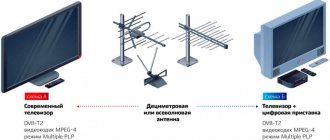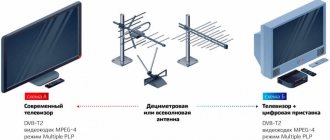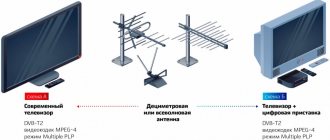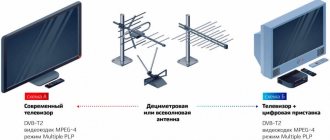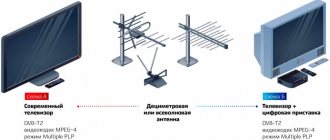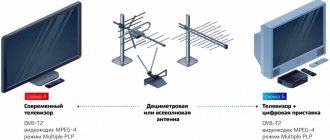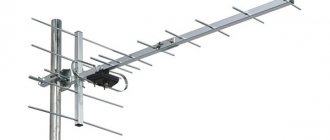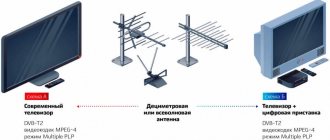How to set up and connect digital TV on your TV in Tambov
Since January 2019, Russia and its regions have been switching from analogue to digital television signals in several stages. This allows you not only to improve the quality of image and sound, but also to increase the number of free channels. Finally, all settlements in Russia, according to information from representatives of the Ministry of Digital Development, Communications and Mass Communications of the Russian Federation, will be able to switch to digital before October 14, 2021. We will tell you what actions need to be performed at home or in the country when your region completely switches to digital TV.
In connection with the mentioned transition to digital broadcasting, those people who watch TV through an antenna, in some cases need to tune in to receive a digital signal. How can I tell if my television is digital or not? If, when you turn on the TV, instead of the usual TV programs you see a video about how to switch to digital, then you have analog television, and you need to perform a number of actions. The absence of an information video means that: you initially have digital television (satellite or Internet TV); you have terrestrial television, but the transition to digital broadcasting has already been completed; Do you have cable TV? The authorities agreed with cable television operators to preserve analogue broadcasting in the cable. But if you want, you can also switch to digital broadcasting in cable. Please note: if you have several TVs at home or in the country, they can receive a TV signal in different ways. For example, in the living room the TV is connected to cable TV, and in the kitchen the reception is via an antenna. How to set up digital TV at your dacha? Before the start of the summer season, we recommend that you find out in advance what type of signal the TV receives in your country house. If you have satellite TV, you don't need to do anything. But if you receive a TV signal using an antenna, prepare in advance to switch to digital TV. How to set up digital if I watch TV through an antenna?
If you have analogue television (there is an “A” next to the central channel logos), find out whether your TV supports the DVB-T2 standard. Digital TVs released after 2012 mostly have a corresponding decoder; those released earlier may not support this format (this is especially true for older analog TVs). You can check whether your TV supports the DVB-T2 standard in the instructions for the TV or using the “Search for information about TV” service on the website of the Russian Television and Radio Broadcasting Network (RTRS). You will need to enter the make and model of your TV. If your TV supports DVB-T2, you just need to set up your TV using the remote: Step 1: Turn off the TV's power. Step 2: Connect the antenna cable to the antenna input of your digital TV. Step 3: Connect the power and turn on the TV. Step 4. Go to the appropriate section of the TV settings menu and activate the digital tuner. Step 5. Automatically search for programs using the instruction manual. You can perform a manual channel search. In this case, you must enter the channel number or frequency. If your TV does not support this format, you need to purchase additional equipment - a digital set-top box (receiver). If you have two TVs that you watch through an antenna, and you want to watch different channels on them, you need to purchase a set-top box for each of them. The digital set-top box needs to be connected to the TV and configured: Step 1. Turn off the power to the TV. Step 2. Connect the antenna cable to the antenna input of the digital set-top box. Connect the video and audio cables to the appropriate jacks on your TV and set-top box. The image quality will be higher when connecting the set-top box to the TV with an HDMI cable. Step 3: Connect the power and turn on the TV. Step 4. From the menu, select the required input source: HDMI, AV, SCART and others. Step 5. Automatically search for digital TV programs using the operating instructions. You can perform a manual search. In this case, you must enter the channel number or frequency. You can also find more information on how to connect digital TV, choose a digital set-top box, where to buy it and how to set it up, on the website of the mentioned Russian Television and Radio Broadcasting Network (RTRS), where, depending on your region, you must call the hotline They will tell you how to troubleshoot possible problems. How can I retune my TV to digital if I have cable TV? If you have cable television and want to set up a digital signal, you need to: Step 1. Enter the menu using the special button on the remote control. Step 2. Go to the “Channel” section, which usually has a satellite dish icon. Step 3. Select "Auto search". Step 4. Select “Cable” from the proposed connection options. Step 5. Next, select “Digital” and click on “Start”. Step 6: If you want to keep the analog channels, select “Analog and Digital”. If you have any additional questions, you can contact your operator's support team. Please note: if you receive a TV signal through cable, but still see an informational video about switching to digital broadcasting, you will need to contact your cable operator's customer service and ask about how you can connect to digital TV within the current tariff. What channels will be available to me after switching to digital TV? If you watch television through an antenna, after switching to a digital signal, 20 mandatory TV channels of the first and second multiplexes will be available to you. The first multiplex includes: Channel One, “Russia 1”, “Match TV”, NTV, “Petersburg - Channel Five”, “Culture”, “Russia 24”, “Carousel”, OTR, “TV Center - Moscow”. The second multiplex includes: REN TV, Spas, STS, Domashny, TV-3, Friday!, Zvezda, Mir, TNT, Muz-TV). If you have cable television, you will have access to those channels that are provided for in your agreement with the operator. At the same time, by agreement between regional authorities and operators, more than 50 TV channels will be available in digital quality, the mos.ru portal reports. Earlier, the Ministry of Telecom and Mass Communications approved a plan for a phased disconnection from analogue television and radio broadcasting in the constituent entities of the Russian Federation as part of the transition to digital in December 2021. The switch-off from analogue broadcasting was decided to be divided into three stages from January to June 2021, namely February 11, April 15 and June 3. During the first wave of transition to digital, analogue TV was replaced in the Penza, Magadan, Ryazan, Ulyanovsk, Tula, Yaroslavl regions, as well as in the Chechen Republic. On April 15, another 20 Russian regions switched from analogue to digital television broadcasting. Among those who switched from analogue to digital TV were Moscow, Moscow region, Kalmykia, Mordovia, Karachay-Cherkessia, Chuvashia, Kabardino-Balkaria, Stavropol Territory, Udmurtia, Yamalo-Nenets Autonomous Okrug, as well as Kemerovo, Amur, Ivanovo, Kirov, Kostroma, Kurgan, Lipetsk, Novgorod, Sakhalin, Tyumen regions. It was planned that the transition process would end with the third stage on June 3, when the remaining 57 regions would be transferred to digital. However, the Russian government decided to extend this period and transfer the remaining regions of Russia to digital in October 2021. “The main task that continues to face all regions, regardless of whether they find themselves in the third or fourth stage, is to by June 3, all the necessary work was done. It’s just that residents of some regions that belong to the fourth stage, if fully ready, will receive analog television for some time,” concluded the deputy head of the Ministry of Telecom and Mass Communications. TOTAL, in October 2019, all regions of Russia: Adygea, Altai, Bashkiria, Buryatia, Dagestan, Ingushetia, Kabardino-Balkaria, Kalmykia, Karachay-Cherkess Republic, Karelia, KOMI, Crimea, Mari El, Mordovia, Sakha (Yakutia), North Ossetia (Alania), Tatarstan, TUVA, Udmurtia, Khakassia, Chechnya, Chuvashia, Altai Territory, Transbaikal Territory, Kamchatka Territory, Krasnodar Territory, Krasnoyarsk Territory, Perm Territory, Perm Territory, Primorsky Territory, Stavropol Territory, Khabarovsk Territory, Amur Region, Astrakhan Region, Arkhangelsk Region , Belgorod region, Bryansk region, Vladimir region, Volgograd region, Vologda region, Voronezh region, Ivanovo region, Irkutsk region, Kaliningrad region, Kaluga region, Kemerovo region, Kirov region, Kostroma region, Kurgan region, Kursk region, Leningrad region, Lipitskaya region, Magadan region, Moscow region, Murmansk region, Nizhny Novgorod region, Novgorod region, Novosibirsk region, Omsk region, Orenburg region, Oryol region, Penza region, Pskov region, Rostov region, Ryazan region, Samara region, Saratov region, Sakhalin region, Sverdlovsk region, Smolensk region, Tambov region, Tver region, Tomsk region, Tula region, Tyumen region, Ulyanovsk region, Chelyabinsk region, Yaroslavl region, federal cities - Moscow, St. Petersburg, Sevastopol, Jewish Autonomous Okrug, Khanty-Mansi Autonomous Okrug, Yamal-Nenets Autonomous Okrug, Nenets and Chukotka Autonomous Okrug - will switch completely to digital television.
03.05.2019 13:46
Digital television broadcasting launched in the Tambov region
Residents of the region whose televisions support the DVB-T2 format will be able to receive in digital quality the channels of the first multiplex - “Channel One”, “Russia-1”, “Russia-2”, “Russia-24”, “Russia-K”, “ NTV", "Petersburg Channel 5", "Carousel". In the future, the package will include Public Television of Russia and TV Center. The second multiplex will have REN-TV, TNT, STS, Zvezda, Domashny, Mir, NTV-Plus Sport-Plus, Sport, Muz-TV. Vice-Governor of the Tambov Region Sergei Chebotarev called this a large-scale project that allows television broadcasting to move to a qualitatively new level and provides new opportunities for the development of cellular communications, the Internet, and obtaining e-government services. Now almost the entire population of the region will be provided with high-quality multi-channel television broadcasting. For comparison, in analogue broadcasting only half of the region’s residents can receive five or more programs, and most of them live in Tambov and its suburbs.
As the administration's press service reported, 31 digital terrestrial television broadcasting stations, as well as 34 radio relay stations, have already been built in the region. By September, it is planned to complete the construction of 14 more digital terrestrial television broadcasting facilities and a Coding and Multiplexing Center, which will allow the programs of regional broadcasters to be included in the federal package.
The process of transition to the digital format of television broadcasting in Russia is carried out within the framework of the Federal Target Program (FTP) “Development of television and radio broadcasting in the Russian Federation for 2009-2015.”
It should be noted that Russia, unlike Europe, is switching to the digital television broadcasting format DVB-T2, bypassing the intermediate DVB-T format. The DVB-T2 format compared to the DVB-T format provides the following advantages: - an increase in the number of TV channels in one frequency range; — the possibility of organizing “local” (local) television broadcasting; — support for high definition TV (HD format).
Background
By Order of the Government of the Russian Federation of March 3, 2012 No. 287-r, the only standard for terrestrial digital television in Russia is DVB-T2.
On March 16, 2012, by decision of the State Commission on Radio Frequencies for broadcasting the DVB-T2 standard, radio frequencies of the meter (174-230 MHz) and decimeter frequency ranges (470-790 MHz) were adopted for use on channels 6-12 and 21-60, respectively.
By Order of the Government of the Russian Federation dated May 24, 2010 No. 830-r, the only contractor for work within the framework of the federal target program “Development of television and radio broadcasting in the Russian Federation for 2009-2015” was determined to be the “Russian Television and Radio Broadcasting Network” (RTRS).
In Russia, RTRS provides the first multiplex in the DVB-T2 standard and is preparing to launch a second multiplex. Multiplexes are free, not encrypted and open to reception.
The creation of a digital television broadcasting network is divided into 4 stages with priority for border areas.
The 1st stage of creating digital television broadcasting networks (2010) includes 12 regions, in particular: the Republic of Altai, the Republic of Buryatia, the Republic of Tyva, the Republic of Khakassia, Altai Territory, Transbaikal Territory, Kamchatka Territory, Primorsky Territory, Khabarovsk Territory, Amur Region , Sakhalin region, Jewish Autonomous Region. Now in all these regions television broadcasting is already carried out in digital format along with traditional analogue.
The 2nd stage of creating digital television broadcasting networks (2011 - 2012) includes 27 regions, in particular: the Republic of Adygea, the Republic of Dagestan, the Republic of Ingushetia, the Kabardino-Balkarian Republic, the Republic of Kalmykia, the Karachay-Cherkess Republic, the Republic of Karelia, the Northern Republic Ossetia - Alania, Chechen Republic, Krasnodar region, Astrakhan region, Belgorod region, Bryansk region, Volgograd region, Voronezh region, Irkutsk region, Kaliningrad region, Kursk region, Leningrad region, Murmansk region, Orenburg region, Pskov region, Rostov region, Smolensk region, Tyumen region, St. Petersburg, Khanty-Mansiysk Autonomous Okrug - Ugra.
The 3rd stage of creating digital television broadcasting networks (2012 - 2013) includes 39 regions, in particular: the Komi Republic, the Mari El Republic, the Republic of Mordovia, the Republic of Tatarstan, the Udmurt Republic, the Chuvash Republic, the Perm Territory, the Stavropol Territory, the Arkhangelsk Region , Vladimir region, Vologda region, Ivanovo region, Kaluga region, Kemerovo region, Kirov region, Kostroma region, Kurgan region, Lipetsk region, Magadan region, Moscow region, Nizhny Novgorod region, Novgorod region, Novosibirsk region, Omsk region, Oryol region, Penza region, Ryazan region, Samara region, Saratov region, Sverdlovsk region, Tambov region, Tver region, Tomsk region, Tula region, Ulyanovsk region, Chelyabinsk region, Yaroslavl region, Moscow, Nenets Autonomous Okrug.
The 4th stage of creating digital television broadcasting networks (2013) includes 5 regions, in particular: the Republic of Bashkortostan, the Republic of Sakha (Yakutia), Krasnoyarsk Territory, Chukotka Autonomous Okrug, Yamalo-Nenets Autonomous Okrug. Pilot zones for testing technological solutions for digital broadcasting networks were the Republic of Tatarstan, Kursk region, Leningrad region, St. Petersburg, Moscow and a number of other cities. At the moment, broadcasting in DVB-T2 format is carried out in Moscow, St. Petersburg, Tatarstan and Khakassia. By the end of 2013, all regions of Russia where broadcasting is carried out in the old standard will be transferred to DVB-T2.
Follow our Telegram channel so you don't miss the most important things!
